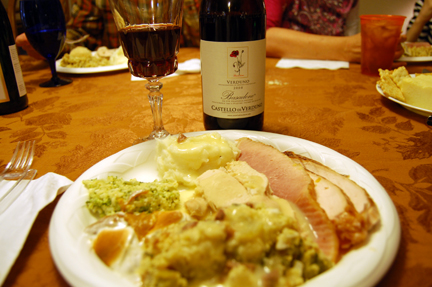
We had a great Thanksgiving yesterday in Orange, Texas with Branch and Johnson and now Parzen families. Mrs. B’s roast turkey; smoked turkey; spiral sliced ham with pineapple, brown sugar, and Coke; Uncle Tim’s cornbread dressing; Memaw’s deviled eggs; sweet potato pie, mashed potatoes; eight-layer salad; Tracie P’s shaved Brussels sprouts salad; pecan torte; and lots more. I wanted to share this story about my favorite wine pairing for this year, Pelaverga by Castello di Verduno, and the somewhat saucy story behind the name. For those with PG13+ status, read on…
The year was 2006 and I was working in New York as the media director for a high-profile Italian restaurant group that also happened to be a direct importer of Italian wines. Earlier that year, I had made the annual trek with my colleagues to the Italian wine fairs, where we met and tasted with a young winemaker at the natural wine fair, Vini Veri: Mario Andrion of Castello di Verduno, producer of awesome Barolo and Barbaresco and a then relatively obscure grape called Pelaverga. I’ve always loved Mario’s traditional-style wines (like his excellent Barbaresco) but all of my colleagues and I agreed that his Pelaverga Basadone was one of the most original wines we’d tasted that year: light in body, bright with acidity, and rich with fresh red fruit flavors, complemented by a gentle “white pepper” note. Later that year, a prominent colleague asked me what my Thanksgiving pick was and I whispered, Pelaverga, the perfect wine to go with wide variety of foods we eat for the holiday, from roast turkey to cranberry sauce.
Don’t ask me how but this vital piece of information was somehow whispered into the ear of the then New York Times restaurant editor Frank Bruni (remember him?). The rest is history: when he picked this wine as his top choice for Thanksgiving 2006, it made Mario’s Pelaverga a household word (at least in Manhattan).

And it’s a highly interesting word at that! No one knows the true origin of the grape name but on face value it means branch scraper, from the Italian pelare (to peel) and verga (branch). Most believe the name has to do with vine training techniques that were used to cultivate this rustic grape.
Of course, verga (and those of you who speak Spanish will immediately see the linguistic kinship) can also denote the… ahem… the male sex. Back in Verduno (Piedmont), the locals say this spicy grape has aphrodisiacal properties and that’s why Castello di Verduno calls it Basadone, the baciadonne or lady kisser.
Tracie P and I hope you had a great holiday! Thanks for reading!




 The food and wine blogosphere went a little nuts a few weeks ago after
The food and wine blogosphere went a little nuts a few weeks ago after 
